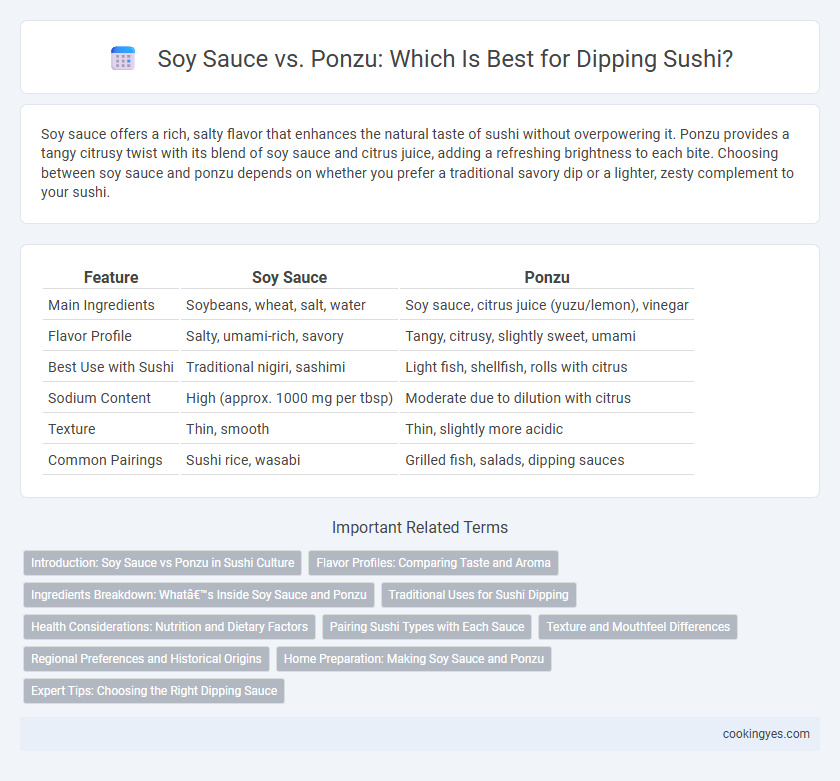Soy sauce offers a rich, salty flavor that enhances the natural taste of sushi without overpowering it. Ponzu provides a tangy citrusy twist with its blend of soy sauce and citrus juice, adding a refreshing brightness to each bite. Choosing between soy sauce and ponzu depends on whether you prefer a traditional savory dip or a lighter, zesty complement to your sushi.
Table of Comparison
| Feature | Soy Sauce | Ponzu |
|---|---|---|
| Main Ingredients | Soybeans, wheat, salt, water | Soy sauce, citrus juice (yuzu/lemon), vinegar |
| Flavor Profile | Salty, umami-rich, savory | Tangy, citrusy, slightly sweet, umami |
| Best Use with Sushi | Traditional nigiri, sashimi | Light fish, shellfish, rolls with citrus |
| Sodium Content | High (approx. 1000 mg per tbsp) | Moderate due to dilution with citrus |
| Texture | Thin, smooth | Thin, slightly more acidic |
| Common Pairings | Sushi rice, wasabi | Grilled fish, salads, dipping sauces |
Introduction: Soy Sauce vs Ponzu in Sushi Culture
Soy sauce and ponzu are essential dipping sauces in sushi culture, each offering distinct flavor profiles that enhance the dining experience. Soy sauce provides a rich, salty umami taste that complements the natural flavors of raw fish, while ponzu delivers a tangy, citrusy zest that brightens the palate. Sushi chefs often select these sauces based on the type of sushi, balancing traditional tastes with modern preferences.
Flavor Profiles: Comparing Taste and Aroma
Soy sauce offers a rich, salty umami flavor with deep, savory notes that enhance sushi's natural sweetness, while ponzu provides a citrusy, tangy brightness combined with a subtle soy base that adds complexity and freshness. The aroma of soy sauce is robust and earthy, complementing the umami intensity, whereas ponzu's scent features zesty hints of yuzu or lemon, delivering a light and invigorating fragrance. Choosing between soy sauce and ponzu depends on whether the preference leans towards a traditional, intense savoriness or a vibrant, refreshing citrus contrast.
Ingredients Breakdown: What’s Inside Soy Sauce and Ponzu
Soy sauce consists primarily of fermented soybeans, wheat, salt, and water, resulting in a rich, salty, and umami flavor ideal for traditional sushi dipping. Ponzu combines soy sauce with citrus juice (such as yuzu or lemon), vinegar, mirin, and dashi, offering a tangy, slightly sweet, and umami-packed profile that brightens the taste of sushi. The key distinction lies in ponzu's citrus and vinegar components, which provide a refreshing contrast to soy sauce's deep, savory essence.
Traditional Uses for Sushi Dipping
Soy sauce remains the traditional dipping choice for sushi, prized for its rich umami flavor that complements the subtle taste of raw fish and vinegared rice. Ponzu, a citrus-based sauce combining soy sauce with yuzu or lemon juice, is traditionally used in specific sushi styles like lighter sashimi and grilled fish to add a refreshing, tangy contrast. Both sauces respect the essence of sushi but cater to different flavor profiles, with soy sauce enhancing depth and ponzu offering a bright, zesty finish.
Health Considerations: Nutrition and Dietary Factors
Soy sauce contains higher sodium levels, which can impact blood pressure and heart health when consumed in excess, while ponzu typically offers a lower sodium alternative enriched with citrus juice, providing vitamin C and antioxidants. Those managing sodium intake or seeking a lighter flavor benefit from ponzu's nutrient profile, which supports hydration and immune function. Soy sauce delivers umami with fermented soy nutrients, but ponzu's blend of soy and citrus supports a more balanced dietary approach for health-conscious sushi enthusiasts.
Pairing Sushi Types with Each Sauce
Soy sauce's rich umami flavor pairs exceptionally well with nigiri and sashimi, enhancing the natural taste of tuna, salmon, and eel without overpowering them. Ponzu offers a citrusy, tangy brightness that complements lighter sushi varieties such as white fish and scallops, adding a refreshing contrast to their delicate flavors. Choosing the right dipping sauce depends on the sushi type, as soy sauce deepens savory notes while ponzu elevates subtle sweetness and freshness.
Texture and Mouthfeel Differences
Soy sauce offers a smooth, velvety texture with a rich, umami depth that coats the palate evenly, enhancing sushi flavors without overpowering them. Ponzu presents a lighter, more refreshing mouthfeel, combining citrusy acidity with subtle soy undertones, creating a tangy and slightly effervescent sensation. The contrast between soy sauce's dense, salty richness and ponzu's crisp, zesty brightness significantly influences the overall sushi tasting experience.
Regional Preferences and Historical Origins
Soy sauce, originating from ancient China and widely adopted across Japan, remains the traditional dipping sauce for sushi with its rich, salty umami flavor. Ponzu, a citrus-based sauce developed later in the Kansai region of Japan, offers a tangy alternative favored in western Japan and increasingly popular worldwide. Regional preferences emphasize soy sauce in Edo-style sushi in eastern Japan, while ponzu pairs well with lighter, delicate sushi varieties, reflecting evolving tastes influenced by local ingredients and historical culinary practices.
Home Preparation: Making Soy Sauce and Ponzu
Homemade soy sauce requires fermenting soybeans and wheat over several months for authentic umami depth, while homemade ponzu blends soy sauce with citrus juice, rice vinegar, and mirin for a tangy, refreshing dip. Soy sauce preparation emphasizes salt concentration and fermentation conditions, affecting its rich, savory profile ideal for traditional sushi pairings. Ponzu's quick mix-and-chill method offers a versatile citrusy alternative, balancing acidity with savory soy, perfect for light, flavorful dipping at home.
Expert Tips: Choosing the Right Dipping Sauce
Soy sauce offers a rich umami depth ideal for enhancing traditional sushi flavors, while ponzu provides a citrusy brightness that lightens heavier textures like fatty tuna. Experts recommend selecting soy sauce for nigiri and sashimi to amplify savory notes, and opting for ponzu when enjoying rolls with fried or grilled components for a refreshing contrast. Balancing the dipping sauce with the specific sushi type ensures the best taste experience and preserves delicate fish textures.
Soy Sauce vs Ponzu for dipping Infographic

 cookingyes.com
cookingyes.com